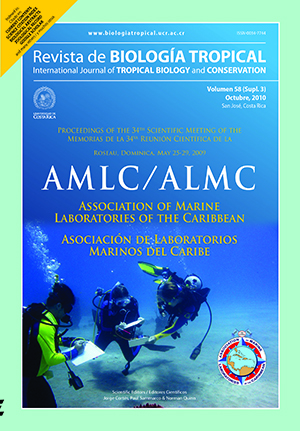Abstract
This study describes temporal and spatial abundance patterns of echinoderm larvae in La Parguera, Puerto Rico. For the temporal study, larvae were sampled by a series of monthly tows taken with a 64μm mesh net between the new and full moon from April 2005 to July 2006, September 2006 and August 2007. In order to measure spatial variation of echinoderm larval abundances, oblique tows were taken with 64 and 202μm mesh nets at seven different sites within the shelf, at the shelf-edge, and at a nearby oceanic stations during August 2007. Overall, Echinoidea (sea urchin) exhibited the highest abundance with a total of 11 921 larvae, representing 52.5% of the total collection. Ophiuroidea (brittle star) ranked second in abundance with 45.6% of the total larvae. Holothuroidea (sea cucumber) and Asteroidea larvae (sea star) accounted for less than 2% of the total echinoderm larval collection. Early larval stages (2-8 day old) of Diadema antillarum represented 20% of the total Echinoidea larvae. There was no marked seasonal trend of echinoderm larval abundance; Echinoidea and Ophiuroidea larvae were present in all monthly samples indicating that reproduction occurs year-round. Peak abundances of later-stage Echinoidea larvae were observed during January, July and October and of later-stage Ophiuroidea larvae during June, August and October. The observed peaks of later-stage larval abundances may be indicative of higher recruitment activity during these months. There was a significant difference of echinoderm larval abundance between spatial stations, with higher abundances collected at the shelf-edge. Later-stage (~24 day old) D. antillarum larvae were mostly collected at shelf-edge and oceanic locations. In addition, the 64mm mesh net was more efficient for collection of echinoderm larvae than the 202mm mesh net.##plugins.facebook.comentarios##

This work is licensed under a Creative Commons Attribution 4.0 International License.
Copyright (c) 2010 Revista de Biología Tropical
Downloads
Download data is not yet available.






